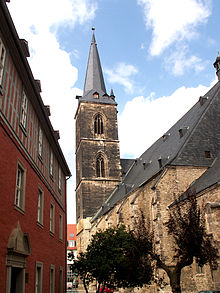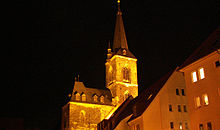St. Stephen's Church (Aschersleben)
The St. Stephen's Church in Aschersleben was built from 1406 to 1507 and is a Gothic hall church . Today it belongs to the Evangelical parish of Aschersleben with the St. Margarethen Church and St. Johannis Church .
The St. Stephen's Church is the largest city church in Saxony-Anhalt and can be visited.
Building history
The St. Stephen's Church is the successor to a smaller Romanesque basilica , which stood in the same place as today's church. The construction of the church began towards the end of the 14th century with the demolition of the towers of the Romanesque basilica. In 1406 the current tower was built, which can still be seen today above the west portal of the church. At the same time, the construction of the high choir began. Part of the material from the towers of the old church was used in the lower part of the tower. The tower was built up to the first floor and then left for about 30 years. During this time, the sandy subsoil under the tower began to settle, which led to problems during the entire construction phase of the towers, and ultimately even resulted in a change in the construction plans for the tower. After completion of the south tower (height approx. 82 meters), the idea of completing the north tower was abandoned. The already planned round decorative window in the tower front was walled up. Construction of the nave did not begin until 1480. The large Gothic church was built around the smaller Romanesque basilica, so to speak, and it was torn down piece by piece during the construction work. Today the southern tower is also on the decline. Regular checks are carried out to determine whether the tower is tilting further.
Timetable
| 1406 | Start of construction of the Gothic towers |
| 1437 | Casting the evening bell |
| 1469 | Completion of the towers |
| 1475 | First lightning strike in the south tower |
| 1480 | Start of construction of the Gothic nave and demolition of the Romanesque nave |
| 1492 | Completion of the walls of the Gothic nave |
| 1494 | The large clock bell is poured and the roof timber is rafted to Aken on the Elbe |
| 1506 | The clockwork will be installed in the south tower |
| 1507 | Church consecration after over 100 years of construction |
| 1575 | Casting of the chamber bell by Eckard Kucher |
| 1826 | The old bridal bell shows a crack |
| 1839 | Font of the new bridal bell |
| 1862 | The church and tower will receive lightning rods |
| 1925 | Casting the Luther bell |
| 1940 | Of the 10 bells, 7 have to be delivered for armament purposes |
| 1950 | In the spring, all 7 bells return from Hamburg to Aschersleben and are hung up again in the south tower and ceremoniously put into service on Ascension Day |
| 1957/58 | Bell machines are installed |
| 2001 | The tower head will be completely renovated and the tower crown will be removed and opened |
Furnishing
The St. Stephen's Church has a rich interior. It houses pictures from the Cranach School in Wittenberg and various other paintings and epithets . In the center of the high choir is the old bronze baptismal font from the 14th century.
The old baroque pulpit from the 17th century is still in the nave. The high altar with gold inscription by the founder on the side, the pulpit in the transitional area between the high choir and nave and the rest of the stalls date from 1905/06, donated by the imperial councilor and large grain dealer Gustav Ramdohr .
Röver organ
The church still houses a Röver - organ from 1907, which the old, 1655-1657, built by Georg Nothnagel and 1712 by the organ builder Christoph Concius ( Wernigerode replaced outdated) organ. In 1907, the prospectus of the previous organ from 1855 was taken over and expanded.
The organ was then equipped with new pipes from 1940 to 1944 by the company Palandt & Sohnle (Hildesheim) . Today the instrument has 51 registers (approx. 3,500 pipes) on three manuals and a pedal . The playing and stop actions are pneumatic.
|
|
|
|
||||||||||||||||||||||||||||||||||||||||||||||||||||||||||||||||||||||||||||||||||||||||||||||||||||||||||||||||||||||||||||||||||||||||||||||||||||||||||||||||||
-
Couple
- Normal coupling: II / I, III / I, III / II, I / P, II / P, III / P
- Super octave coupling: II / I
- Sub-octave coupling: II / I, III / II
Organ prospectus
In 1907 a total of 26 oil paintings by former members of the Aschersleben magistrate were hung around the organ. These were made around 1660 to commemorate the “excellent management of the city” during the Thirty Years War by the painter Wulf Ernst Lindemeyer (* 1601; † around 1663) from Halberstadt. They show:
- three mayors: Ascan Pflaume , Daniel Lindau, Joh. Hertzog
- three city bailiffs: Daniel Hauenschild, Valentin Zwanzig, Joh. Roloff
- two mayors: Gottfried Herwig and Andreas Müller (the 3rd was Valentin Drosihn)
- two riders: Johann Müller and Johann Wolff (the 3rd Erasmus Beyse had died shortly before)
- two Chamberlain: David Beyse and Daniel Pfeiffer (the 3rd missing)
- three chamberlains: Valentin Lamprecht, Theodor Herzog, Balthasar Büssdorf
- three riders: Andreas Gräffenstein, Busse Maschau, Caspar Niethard
- three main builders: David Waldmann, Michael Heise, Caspar Heyberg
- three wine owners: Asmus Pflaume, Valentin Lamprecht II, Hennig Müller, and
- two clients: Joachim Ramdohr and Burchard Hecht (the third one is missing).
One of the councilors did not want to be painted, namely the mayor Valentin Drosihn, because, as they say, he was ashamed of his big nose.
Bells
Today the church has a total of ten bells , six of which are in the bell room, five of which are rung electrically. Two more bells are in a bay window on the north side of the tower. These are the bells of the striking mechanism that are out of order. In the southern part of the nave there is a small belfry with two bells that come from the roof turret above the high choir. These bells are the baptismal and hospital bells . The bell is in a technically defective condition, which will have to be overhauled.
|
No. |
Name (Name) |
Casting year |
Foundry, casting location |
Diameter (mm) |
Mass (kg) |
Percussive ( HT - 1 / 16 ) |
| 1 | Chamber bell | 1575 | Eckard Kucher, Erfurt | 1830 | 3710 | b 0 -4.5 |
| 2 | Sunday bell | 1331 | unknown | 1600 | 2400 | c 1 +4 |
| 3 | Luther bell | 1925 | Schilling, Apolda | 1300 | 1332 | it 1 −2 |
| 4th | Evening bell | 1437 | probably Joh. Floris | 1120 | 879 | g 1 +2 |
| 5 | Ave Maria bell | 2nd half of the 13th century | unknown | 920 | 355 | as 1 −6 |
| 6th | Little bell | 2nd half of the 13th century | unknown | 830 | 342 | b 1 +3 |
| I. | Striking the hour bell | 1494 (?) | unknown | 1170 | 776 | e 1 −7 |
| II | Quarter-strike bell | 13th century | unknown | 630 | 276 | g 2 −6 |
| III | Roof turret, baptismal bell | 14th century | unknown | 330 | 40 | ~ it 3 |
| IV | House bell, hospital bell | 14th century | unknown | 230 | 25th | ~ b 3 |
photos
literature
- U. Stephan, W. Schlothauer: 500 years of the St. Stephani town church in Aschersleben . 1st edition. Buchhaus am Markt, December 2006, ISBN 978-3-00-020488-3 .
Web links
Individual evidence
- ↑ https://kircheaschersleben.wordpress.com/unsere-kirchen/
- ↑ pretzien.de
- ↑ evangelische-kirche-aschersleben.de ( Memento of the original from May 4, 2008 in the Internet Archive ) Info: The archive link was inserted automatically and has not yet been checked. Please check the original and archive link according to the instructions and then remove this notice.
- ↑ https://www.orgelbau-huefken.de/fileadmin/user_upload/Restaurierung/aschersleben-roeverorgel/aschersleben-roever-disposition.pdf
- ↑ Prof. Dr. Emil Strasbourg: History of the city of Aschersleben . Neudruck, Naumburg / Saale 2003, p. 297
- ^ Entry on regiowiki.hna and article by Griep, Hans-Günther (1963): Daniel and Wulf-Ernst Lindemeyer. Painter, wood cutter and copper engraver in Goslar (1601–1663) , in: Harz magazine. Vol. 15, 1963, p. 105
- ↑ Constanze Treuber u. a .: Cast diversity. Bells in Saxony-Anhalt . Hinstorff, Rostock 2007, pp. 19-22.
Coordinates: 51 ° 45 ′ 14.2 " N , 11 ° 27 ′ 18.3" E









